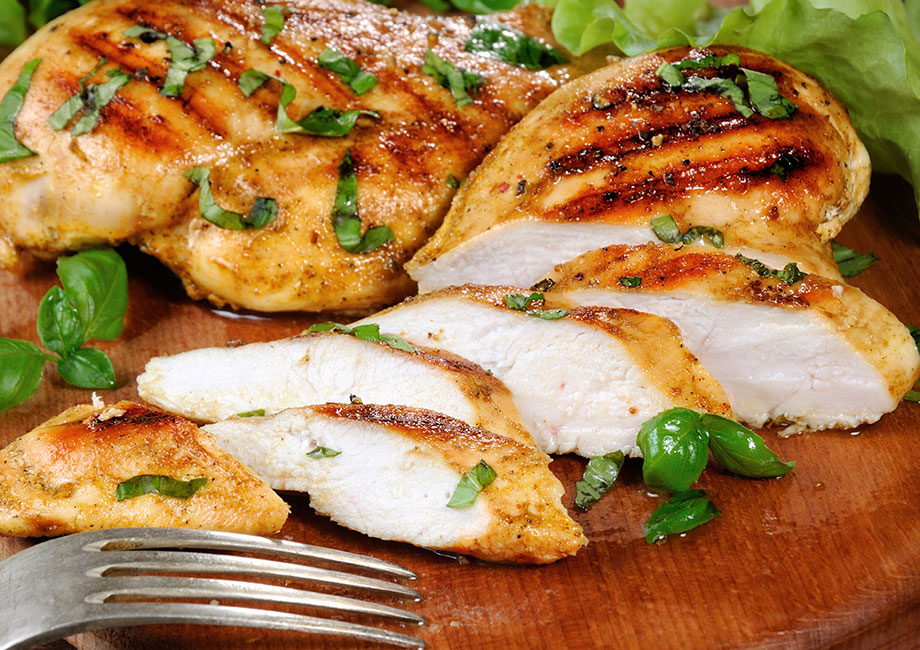We test and review fitness products based on an independent, multi-point methodology. If you use our links to purchase something, we may earn a commission. Read our disclosures.
Since the dawn of fitness history, we can probably be safe in assuming that chicken breast protein has been the staple in the bodybuilding meal plans of avid protein eaters. A source of zero carbs, minimal dietary fat, and just universally tasty, chicken breast can fit into almost anyone’s diet.
As a lean source of all nine essential amino acids, you don’t need a large serving size of any cut of chicken to get a good dose of high-quality protein. What’s more, its neutral flavor makes it easy to season, which is probably why you’ll find chicken in nearly every cuisine.
RELATED: High-Protein, Low-Carb Foods
So, let’s take a closer look at what’s become a standard source of animal protein along with what other nutrients it offers, how the other parts of the chicken measure up, and how cooking methods affect the nutrition.
Medical disclaimer: This article is intended for educational and informational purposes only. It is not intended as a substitute for medical advice. For health advice, contact a licensed healthcare provider.
How Much Protein is in Chicken Breast?
Before we begin, note that all nutritional values have been sourced from the USDA nutritional database1.
A serving of 4 to 6 ounces of boneless skinless chicken breast contains about 35 to 53 grams of protein. It is important to consider whether bones or skin are present since these parts will affect the weight of the chicken but not its protein content.
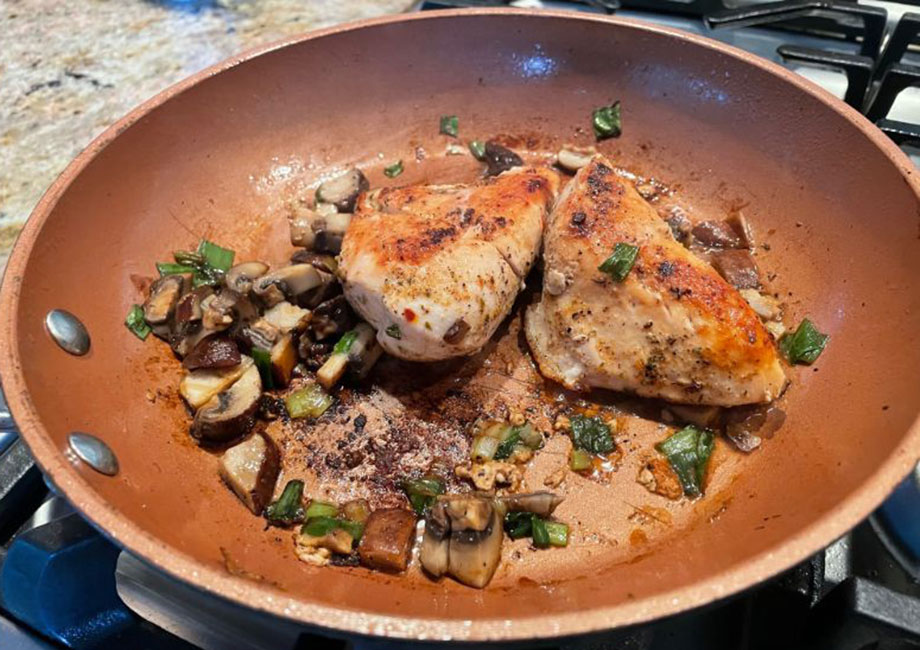
It’s also important to assess the cooking method. The macros above are for a chicken breast that has been grilled, roasted or baked without any additional ingredients added. Given that there are no carbohydrates in a chicken breast and there’s also only about 1 ounce of fat per ounce of chicken, this is what a dietitian such as myself would call an “efficient” source of protein. This means that, ounce per ounce and calorie per calorie, you get more protein.
RELATED: High-Protein Meals
For comparison, 4 ounces of fried chicken breast only has about 28 grams of protein and a whopping 15 grams of fat, 11 more grams than dry cooking methods and over 100 more calories. Not the most ideal source of protein, given that this extra fat is mostly trans fat, which is objectively quite bad for your body—your heart especially2. Additionally, the breading that comes with fried chicken adds weight and lowers the overall protein content without adding any nutritional value.
RELATED: Best Heart Healthy Meal Delivery
How Many Calories Are in Chicken Breast?
When tracking your calories and macros from chicken breast, remember to weigh and track data from the chicken after you’ve cooked it, as water and fat losses from a raw chicken breast will change the nutrition slightly.
That said, 4 ounces of cooked chicken breast contains about 187 calories. If fat or other caloric condiments were added during the cooking process, account for that. It’s also important to consider the skin, which is best removed if you’re wanting to monitor your calories. Even baked chicken breast can hold a surplus of calories in the skin.
Remember, out of these 187 calories, you’ll get 35 grams of protein. Compare this to how much protein you get in a protein source like salmon, which is about 180 calories for 4 ounces but only offers 23 grams of protein along with 9 grams of fat. Granted, this is mostly heart-healthy, polyunsaturated fats, but if you’re trying to keep your macros tightly controlled, chicken breast is the superior protein source in that context.
Chicken Breast Protein vs. Other Parts of the Chicken
So, that’s the breakdown of chicken breast, the leanest part of the chicken. However, what about the dark meat? How does it measure up as a source of protein and what are the nutritional values? Let’s take a look.
Note: I would like to point out that here we will not be assessing raw chicken, as that is not the way we normally consume it (at least I don’t!). All nutrition facts listed are for chicken that has been baked, roasted, or grilled.
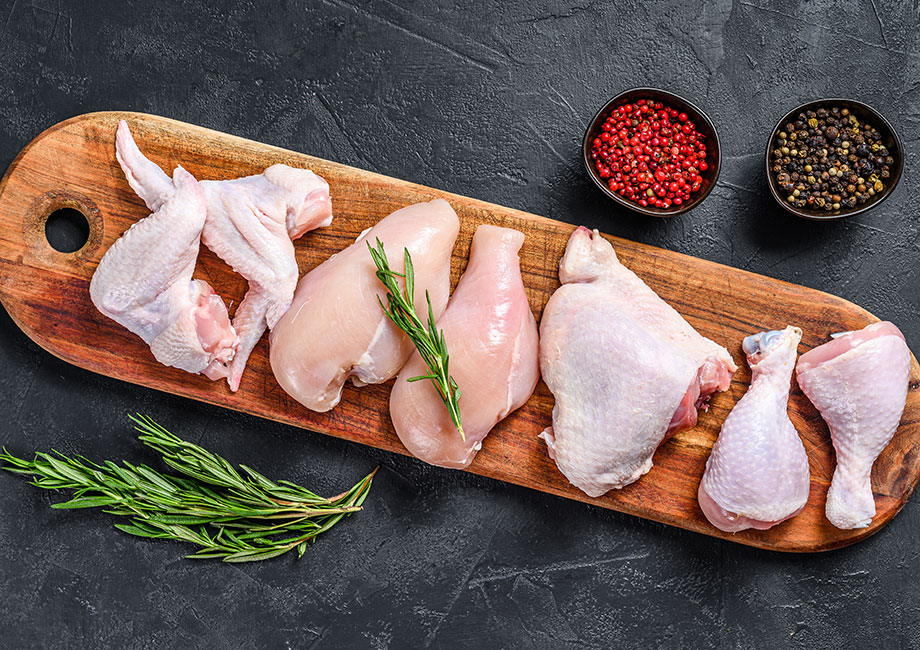
Chicken Thigh
The calories and macros for a 4-ounce chicken thigh without skin on are as follows:
- Calories: 202
- Fat: 9 grams
- Saturated fat: 3 grams
- Carbs: 0 grams
- Protein: 28 g
Chicken Leg
The calories and macros for a 4-ounce chicken leg with skin on and without the bone (equivalent to one drumstick) are as follows:
- Calories: 208
- Fat: 10 grams
- Saturated fat: 3 grams
- Carbs: 0 grams
- Protein: 24 g
Chicken Wing
The calories and macros for 4 ounces of chicken wings with skin on are as follows:
- Calories: 286
- Fat: 19 grams
- Saturated fat: 6 grams
- Carbs: 0 grams
- Protein: 27 g
As you can see, the other parts of the chicken have much more fat and calories that come along with their protein content. That doesn’t mean that they should be ruled out as a source of protein, as these extra calories could be helpful for those trying to build muscle in a calorie surplus.
RELATED: High-Protein Foods for Muscle-Building
However, given the saturated fat content, it would be best to balance the alternative cuts of chicken with sources that have a healthier ratio of fat to protein. Remember, these are nutrition facts for grilled chicken. The calorie and fat content will only increase if you fry or add oil via other methods during preparation.
Benefits of Chicken Breast Protein
Source of Phosphorus
According to the USDA, one 6-ounce chicken breast provides 33% of your daily value of phosphorus. In addition to its role in cell membrane structure, phosphorus is also a key component of the body’s energy source, ATP3. Therefore, some posit that phosphorus can play a role in enhancing athletic performance, but more research is needed to back that claim.
Phosphorus also works with calcium to regulate the metabolism and absorption of Vitamin D4. Vitamin D has been shown to have benefits for boosting athletic performance5, such as an increase in hypertrophy efficiency, injury prevention, and aerobic performance.
RELATED: Hypertrophy Workout
Increases Lean Protein Intake
When a dietitian says “lean protein,” just know that we mean the food source provides a lot of protein without a lot of fat. Chicken, shrimp, scallops, and even pork loin (it’s true, look it up!) all fall under this category.
However, chicken is the most approachable due to having a universally liked flavor and texture, and you don’t have to eat a ton of it to hit your daily protein numbers. Thus, if you’re in your cutting or bulking season and need a filling source of high-protein goodness, cooking up a serving of chicken is the way to go.
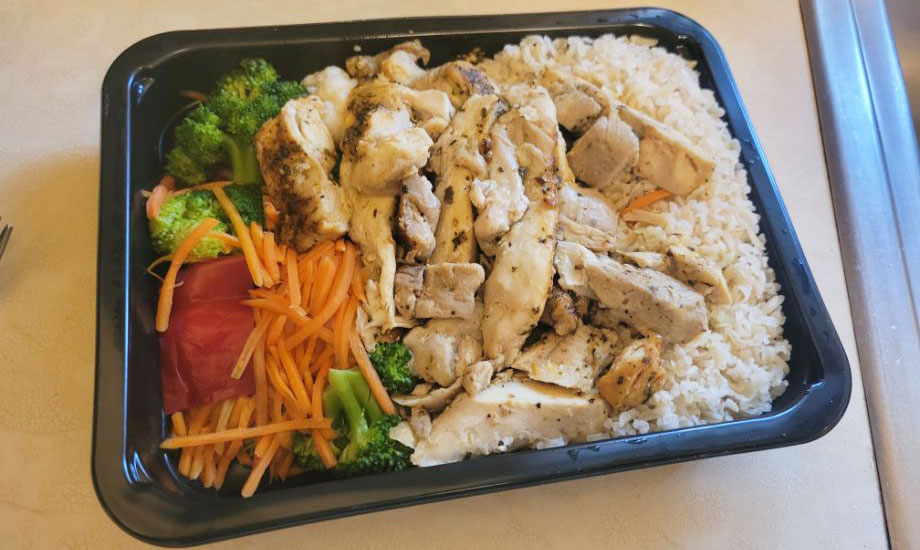
Versatile
As mentioned, you can find chicken in almost any cuisine. This is likely due to the neutral flavor it has, unlike beef and fish, which absorbs any seasonings that are added to it while cooking. Chicken also holds up to most cooking methods and can be shredded, chopped, ground…well, you get the idea. Basically, it’s a high-protein culinary tool you can easily include in your meal plans.
RELATED: High Protein Meal Delivery
Affordable
Other high-protein foods like salmon provide flavor and health benefits but can get expensive if you eat them every day, especially for those with high protein needs. The good news is that chicken tends to be relatively affordable, which is great for people who prefer to prepare meals in bulk and need to buy a lot of it at once. If you opt for free-range, organic brands of chicken, you can expect it to get a little more pricey, but conventional sources tend to be quite reasonable.
RELATED: Cheapest Meal Delivery Service
Great for Weight Loss
Studies have shown6 that eating more protein than the recommended daily allowance is effective at inducing weight loss. The same study also shows that adhering to a high-protein diet may help keep weight off even after weight loss has been achieved, which is arguably the most difficult part of the journey. This is because protein promotes satiety—which is a feeling of fullness—so including protein in your meals and snacks throughout the day is not only a great method to build muscle, but to manage your weight as well.
RELATED: High-Protein Foods List for Weight Loss
Chicken has also been shown to be very beneficial for weight loss because of the amount of protein that it contains. However, since chicken has low levels of total fat and calories relative to its protein content, it also plays a helpful role in maintaining a healthy weight, so long as you cook it in a way that does not increase the number of calories.
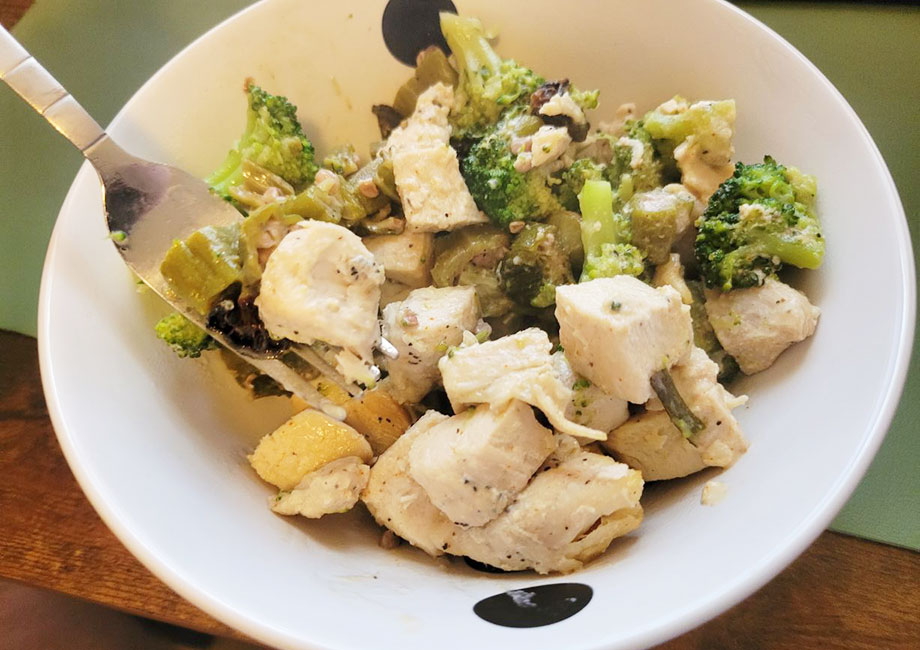
Chicken Breast Protein: Final Thoughts
So, we’ve established that chicken breast is one of the tastiest and most accessible ways to increase your protein intake. However, there are a few things to consider if you want to include more chicken in your diet while staying healthy and balanced.
Firstly, it’s best to choose chicken breast as your usual cut of chicken while including dark meat like the thigh and leg now and then if you want to change it up. This is solely to limit your intake of saturated fats, which can also be achieved by removing the skin before preparing your chicken.
Second, it’s easy to get so wrapped up in the protein content of food that you let other nutrients fall by the wayside. Remember, carbohydrates from whole grain sources are also important for health and athletic performance, along with dietary fiber from plenty of fruits and vegetables.
A healthy combination of protein, carbohydrates, and produce is the best way to ensure you both hit your numbers and give your body the balanced nutrition it needs to prevent chronic disease and optimize your athletic performance. All in all, chicken breast is one of the best high-protein foods to add to your diet, no matter what your fitness and wellness goals are.
Chicken Breast Protein: FAQs
How much protein is in 1 chicken breast?
The average cooked chicken breast is about 6 ounces, which contains about 53 grams of protein.
Is chicken breast the best source of protein?
Given its low cholesterol and fat content, boneless, skinless chicken breast is a source of protein that’s among the most affordable and versatile when compared to other sources.
What is the best way to prepare chicken breast?
The cooking method of chicken breast greatly influences its macronutrient content. Thus, if you are utilizing chicken breast as a source of lean protein, the best way to cook it is baking, roasting, or grilling your chicken without breading or overuse of sauces and condiments.
These statements have not been evaluated by the Food and Drug Administration. This product is not intended to diagnose, treat, cure, or prevent any diseases.
References
- Haytowitz, Ahuja, Showell, et al. Composition of foods raw, processed, prepared USDA National Nutrient database for standard reference, Release 28: Ag Data Commons. Composition of Foods Raw, Processed, Prepared USDA National Nutrient Database for Standard Reference, Release 28 | Ag Data Commons. May 24, 2022. Accessed October 3, 2023
- Iqbal MP. Trans fatty acids – A risk factor for cardiovascular disease. Pak J Med Sci. 2014 Jan;30(1):194-7. doi: 10.12669/pjms.301.4525. PMID: 24639860; PMCID: PMC3955571.
- Erdman JW, MacDonald IA, Zeisel SH, eds. Present Knowledge in Nutrition: Erdman/Present Knowledge in Nutrition. 10th ed. Wiley-Blackwell; 2012.
- Trautvetter U, Ditscheid B, Jahreis G, Glei M. Habitual Intakes, Food Sources and Excretions of Phosphorus and Calcium in Three German Study Collectives. Nutrients. 2018;10(2):171. Published 2018 Feb 2. doi:10.3390/nu10020171
- de la Puente Yagüe M, Collado Yurrita L, Ciudad Cabañas MJ, Cuadrado Cenzual MA. Role of Vitamin D in Athletes and Their Performance: Current Concepts and New Trends. Nutrients. 2020;12(2):579. Published 2020 Feb 23. doi:10.3390/nu12020579
- Moon J, Koh G. Clinical Evidence and Mechanisms of High-Protein Diet-Induced Weight Loss. J Obes Metab Syndr. 2020;29(3):166-173. doi:10.7570/jomes20028
Further reading

Inertia Wave is designed as a lighter, more portable battle ropes alternative. We've tested and reviewed a pair over the past three months both in house and by others and although we initially were extremely skeptical, we do think it's a great replacement for the ever-popular and overly-bulky battle ropes. If you're low on space, enjoy portability, and want a great conditioning tool, the Inertia Wave is a serious option to consider. Read more

What are the main kettlebell benefits? Find out why you should incorporate these, according to an Olympic athlete. Read more

There are many health benefits associated with sauna use, but are saunas good for your skin? We have the answer to this and more! Read more

The GymNext Flex Timeris a gym timer controlled by your phone via Bluetooth. We found that we preferred using our phone instead of the remote we often lost and liked the ease of programming via the app. If you're wanting a gym timer for your Garage Gym or Commercial Gym, this is a great option. Read more

